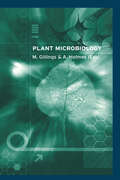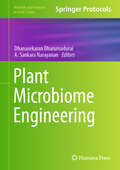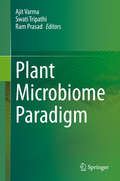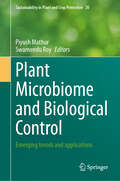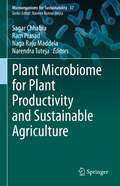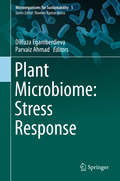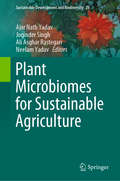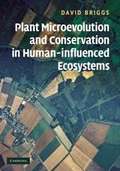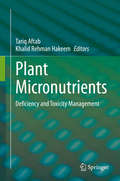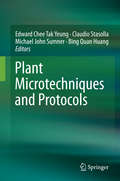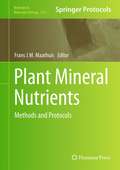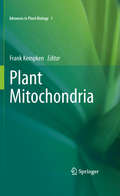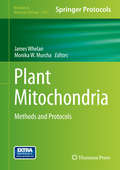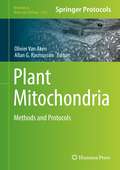- Table View
- List View
Plant Microbiology
by Andrew Holmes Michael GillingsPlant Microbiology provides a comprehensive source of information on DNA sequencing and mapping, the newest technology and procedures in areas such as radiation hybrid mapping, FISH and specialized sequencing techniques are covered. The book also describes how transgene expression is controlled in plants and how advanced information strategies can be used to manipulate and modify the plant genome. An exciting final chapter provides and overview of all the applications of plant transformation in agriculture, medicine and industry.
Plant Microbiome Engineering (Methods and Protocols in Food Science)
by Dhanasekaran Dharumadurai A. Sankara NarayananThis volume provides lab-oriented protocols to deal the various plant microbiome engineering approaches in a lucid and simple manner. Chapters are divided into four section detailing plant associated microbiomes, single cell genomics, whole community metagenomics, metabolic network monitoring and advanced methods in plant microbiome engineering. Written in the format of the Methods and Protocols in Food Science series, the chapters include an introduction to the respective topic, list necessary materials and reagents, detail well-established and validated methods for readily reproducible laboratory protocols and contain notes on how to avoid or solve typical problems. Authoritative and cutting-edge, Plant Microbiome Engineering aims to provide well-established protocols and procedures largely used by both academics and industrials.
Plant Microbiome Paradigm
by Ajit Varma Ram Prasad Swati TripathiThis book provides a comprehensive overview of the current state of knowledge on plant-microbiome interactions and associations. It covers all major mechanistic approaches used to investigate microbes’ impacts on plant growth promotion, disease control and health.The industrial manufacture of nitrogen currently accounts for roughly 2% of the world’s total energy consumption. Microbial products are expected to reduce the need for costly fertilizers, as well as chemical pesticides and fungicides. While beneficial microorganisms are increasingly being used in agriculture, abiotic and biotic stresses such as heat, drought, cold, and salt can quickly kill or render them useless in the field. However, discovering new and better treatments is a lengthy process due to the considerable microbial diversity found in soils.Researchers have now proposed using biotechnological approaches to accelerate the process of microbial technology development. The fact that plant-associated microbes stimulate plant growth and development is well known, as the examples of rhizobia and mycorrhizal fungi show. The mechanisms by which these microorganisms maintain plant growth include the production of phytohormones, fixation of nitrogen, and the mobilization of phosphorus and minerals. The plant microbiome is also involved in pathogen suppression, and especially the root microbiome acts as a protective shield against soil-borne pathogens.A special feature of this book is its multidisciplinary approach, spanning from plant microbiology/biocontrol, fungal and bacterial endophytes, plant physiology, to biochemistry, proteomics and genomics. It is ideally suited for researchers and student of agri-biotechnology, soil biology and fungal biology.
Plant Microbiome and Biological Control: Emerging trends and applications (Sustainability in Plant and Crop Protection #20)
by Swarnendu Roy Piyush MathurThis book offers a comprehensive guide to discovering, assessing, and utilizing consortia of beneficial microbes for crop protection and enhanced crop production in the context of climate change. It provides deep insights into the functional roles of the rhizomicrobiome, including AMF, endophytes, PGPRs, and the phyllomicrobiome, as well as the microbiomes of different plant parts such as seeds, fruits, and stems, in promoting plant growth, development, and the biocontrol of pests and pathogens in a sustainable manner. The book also presents the latest updates on molecular biology techniques, genetic engineering, biotechnological tools, and metagenomics, which are widely used for analyzing plant-pathogen interactions and microbial identification. It will be especially valuable for students and faculty involved in the study and teaching of plant–microbe interactions, as well as researchers working on sustainable methods for plant disease management. With cutting-edge research from leading experts, this book aims to contribute to the development of an eco-friendly, sustainable agricultural system.
Plant Microbiome for Plant Productivity and Sustainable Agriculture (Microorganisms for Sustainability #37)
by Narendra Tuteja Naga Raju Maddela Ram Prasad Sagar ChhabraThis edited book deals with latest comprehensive information on conventional and high throughput techniques and technologies that are recently used to study plant microbial interface for agricultural research and enhancing plant productivity. Plant microbiota are important for many plant growth promotion activity and agricultural productivity and are sustainable green technology for enhancing agricultural productivity under changing environment. The book covers recent information about the plant associated microbiota and their ecology. It discusses technologies to isolate and test microbiota inhabiting in different portion of plants. The book explores the conventional methods as well as the most recently recognized high throughput technologies which are important for productive agroecosystems to feed the growing global population.This book is of interest to teachers, researchers, microbiologist, plant and environmental scientist and those interested in environment stewardship around the world. Also the book serves as additional reading material for undergraduate and graduate students of agriculture, forestry, ecology, soil science, and environmental sciences and policy makers to be a useful to read.
Plant Microbiome: Stress Response
by Parvaiz Ahmad Dilfuza EgamberdievaThis book presents state-of-the-art research on the many facets of the plant microbiome, including diversity, ecology, physiology and genomics, as well as molecular mechanisms of plant-microbe interactions. Topics considered include the importance of microbial secondary metabolites in stimulating plant growth, induced systemic resistance, tolerance to abiotic stress, and biological control of plant pathogens. The respective contributions show how microbes help plants to cope with abiotic stresses, and represent significant progress toward understanding the complex regulatory networks critical to host-microbe interaction and plant adaptation in extreme environments. New insights into the mechanisms of microbial actions in inducing plant stress tolerance open new doors for improving the efficacy of microbial strategies, and could produce new ways of economically increasing crop yields without harming the environment. As such, this book offers an essential resource for students and researchers with an interest in plant-microbe interaction, as well as several possibilities for employing the plant microbiome in the enhancement of crop productivity under future climate change scenarios.
Plant Microbiomes for Sustainable Agriculture (Sustainable Development and Biodiversity #25)
by Joginder Singh Ajar Nath Yadav Ali Asghar Rastegari Neelam YadavThis book encompasses the current knowledge of plant microbiomes and their potential biotechnological application for plant growth, crop yield and soil health for sustainable agriculture. The plant microbiomes (rhizospheric, endophytic and epiphytic) play an important role in plant growth, development, and soil health. Plant and rhizospheric soil are a valuable natural resource harbouring hotspots of microbes, and it plays critical roles in the maintenance of global nutrient balance and ecosystem function. The diverse group of microbes is key components of soil–plant systems, where they are engaged in an intense network of interactions in the rhizosphere/endophytic/phyllospheric. The rhizospheric microbial diversity present in rhizospheric zones has a sufficient amount of nutrients release by plant root systems in form of root exudates for growth, development and activities of microbes. The endophytic microbes are referred to those microorganisms, which colonize in the interior of the plant parts, viz root, stem or seeds without causing any harmful effect on host plant. Endophytic microbes enter in host plants mainly through wounds, naturally occurring as a result of plant growth, or through root hairs and at epidermal conjunctions. Endophytes may be transmitted either vertically (directly from parent to offspring) or horizontally (among individuals). The phyllosphere is a common niche for synergism between microbes and plant. The leaf surface has been termed as phyllosphere and zone of leaves inhabited by microorganisms as phyllosphere. The plant part, especially leaves, is exposed to dust and air currents resulting in the establishments of typical flora on their surface aided by the cuticles, waxes and appendages, which help in the anchorage of microorganisms. The phyllospheric microbes may survive or proliferate on leaves depending on extent of influences of material in leaf diffuseness or exudates. The leaf diffuseness contains the principal nutrients factors (amino acids, glucose, fructose and sucrose), and such specialized habitats may provide niche for nitrogen fixation and secretions of substances capable of promoting the growth of plants. The microbes associated with plant as rhizospheric, endophytic and epiphytic with plant growth promoting (PGP) attributes have emerged as an important and promising tool for sustainable agriculture. PGP microbes promote plant growth directly or indirectly, either by releasing plant growth regulators; solubilization of phosphorus, potassium and zinc; biological nitrogen fixation or by producing siderophore, ammonia, HCN and other secondary metabolites which are antagonistic against pathogenic microbes. The PGP microbes belong to different phylum of archaea (Euryarchaeota); bacteria (Acidobacteria, Actinobacteria, Bacteroidetes, Deinococcus-Thermus, Firmicutes and Proteobacteria) and fungi (Ascomycota and Basidiomycota), which include different genera namely Achromobacter, Arthrobacter, Aspergillus, Azospirillum, Azotobacter, Bacillus, Beijerinckia, Burkholderia, Enterobacter, Erwinia, Flavobacterium, Gluconoacetobacter, Haloarcula, Herbaspirillum, Methylobacterium, Paenibacillus, Pantoea, Penicillium, Piriformospora, Planomonospora, Pseudomonas, Rhizobium, Serratia and Streptomyces. These PGP microbes could be used as biofertilizers/bioinoculants at place of chemical fertilizers for sustainable agriculture. The aim of “Plant Microbiomes for Sustainable Agriculture” is to provide the current developments in the understanding of microbial diversity associated with plant systems in the form of rhizospheric, endophytic and epiphytic. The book is useful to scientist, research and students related to microbiology, biotechnology, agriculture, molecular biology, environmental biology and related subjects.
Plant Microevolution and Conservation in Human-Influenced Ecosystems
by David BriggsAs human activities are increasingly domesticating the Earth's ecosystems, new selection pressures are acting to produce winners and losers amongst our wildlife. With particular emphasis on plants, Briggs examines the implications of human influences on micro-evolutionary processes in different groups of organisms, including wild, weedy, invasive, feral, and endangered species. Using case studies from around the world, he argues that Darwinian evolution is ongoing. He considers how far it is possible to conserve endangered species and threatened ecosystems through management, and questions the extent to which damaged landscapes and their plant and animal communities can be precisely recreated or restored. Many of Darwin's ideas are highlighted, including his insights into natural selection, speciation, the vulnerability of rare organisms, the impact of invasive species, and the effects of climate change on organisms. An important text for students and researchers of evolution, conservation, climate change and sustainable use of resources.
Plant Micronutrients: Deficiency and Toxicity Management
by Khalid Rehman Hakeem Tariq AftabPlants require essential nutrients (macronutrients and micronutrients) for normal functioning. Sufficiency range is the levels of nutrients necessary to meet the plant’s needs for optimal growth. This range depends on individual plant species and the particular nutrient. Nutrient levels outside of a plant’s sufficiency range cause overall crop growth and health to decline, due either to deficiency or toxicity from over-accumulation. Apart from micronutrients (B, Cl, Mn, Fe, Zn, Cu and Mo), Aluminum (Al), cerium (Ce), cobalt (Co), iodine (I), lanthanum (La), sodium (Na), selenium (Se), silicon (Si), titanium (Ti), and vanadium (V) are emerging as novel biostimulants that may enhance crop productivity and nutritional quality. These beneficial elements are not "essential" but when supplied at low dosages, they augment plant growth, development, and yield by stimulating specific molecular, biochemical, and physiological pathways in responses to challenging environments.The book is the first reference volume that approaches plant micronutrient management with the latest biotechnological and omics tools. Expertly curated chapters highlight working solutions as well as open problems and future challenges in plant micronutrient deficiency or toxicity. We believe this book will introduce readers to state-of-the-art developments and research trends in this field.
Plant Microtechniques and Protocols
by Edward Chee Tak Yeung Claudio Stasolla Michael John Sumner Bing Quan HuangA proper understanding of the structural organization of the plant body is essential to any study in plant biology. Experimental studies in vivo and in situ will lead to structural, physiological, and cellular changes of the experimental material. To study macroscopic and microscopic changes, different histological methods and microtechniques can be used as they provide valuable information of the experimental system. In addition, the observed structural changes allow investigators to set hypothesis for further studies based on one's own observation. Thus, proper selection and utilization of microtechniques are a must for the success of a research program. At present, an up-to-date collection of protocols are not readily available in the literature. The latest work in plant microtechniques was published in 1999 by Ruzin but many others are no longer in print [e. g. , Jensen (1964); O'Brien and McCully (1981)]. Furthermore, a majority of published works focus on techniques related to general processing and staining procedures. A comprehensive treatment that encompasses broader applications of microtechniques to other disciplines is lacking [e. g. , archeology, wood science, etc. ]. There is a need to create a comprehensive volume of botanical methods and protocols which includes traditional and novel techniques that can be used by researchers in plant science and investigators in other disciplines that require plant microtechniques in their research and teaching. This book covers a wide variety of applications and brings them up-to-date to make them understandable and relevant, especially to students using the methods for the first time. It is our intention to create a useful reference for plant histology and related methods that will serve as a foundation for plant scholars, researchers, and teachers in the plant sciences.
Plant Migration: The Dynamics of Geographic Patterning in Seed Plant Species
by Jonathan D. SauerUsing cases of plant migration documented by both historical and fossil evidence, Jonathan D. Sauer provides a landmark assessment of what is presently known, and not merely assumed, about the process.
Plant Mineral Nutrients
by Frans J.M. MaathuisThe study of plant mineral nutrition has both academic and applied aspects to it. Today, research into plant mineral nutrition is more pertinent than ever in the face of a growing world population and the increasing need for sustainable agriculture. In Plant Mineral Nutrients: Methods and Protocols, expert researchers in the field detail a comprehensive collection of methodologies that are routinely used in plant mineral nutrition research. These include methods and protocols for plant growth parameters, ion contents and composition, soil analyses, flux measurements and the use of public facilities for high throughput analyses. Written in the highly successful Methods in Molecular BiologyTM series format, chapters include introductions to their respective topics, lists of the necessary materials and reagents, step-by-step, readily reproducible laboratory protocols, and key tips on troubleshooting and avoiding known pitfalls. Authoritative and practical, Plant Mineral Nutrients: Methods and Protocols seeks to aid scientist in the further study of into plants and their mineral nutrients.
Plant Mitochondria
by Frank KempkenMitochondria are the product of a long evolutionary history. It is now a well established fact that mitochondria did evolve from free living bacteria being the common ancestor of both, eukaryotic mitochondria and α-proteobacteria. Advances in genome sequencing, the establishment of in organello and in vitro assays to name only a few, contributed significantly to advances in plant mitochondrial research. Second generation sequencing and the ability to directly sequence and analyse the whole plant transcriptome certainly will help to develop the research on plant mitochondria to another level in the future. In this book the current knowledge about plant mitochondria is presented in a series of detailed chapters, which have been organized in five main sections: (i) dynamics, genes and genomes; (ii) transcription and RNA processing; (iii) translation and import; (iv) biochemistry, regulation and function; and (v) mitochondrial dysfunction and repair. These sections consist of two to five chapters, each written by well-known specialists in the field. This book thus provides a comprehensive inside in the field of plant mitochondria for the specialist. The addition of a glossary and text boxes to each chapter provides easy access for readers from other subjects and hopefully will attract young scientist to the fascinating and exiting field of plant mitochondria.
Plant Mitochondria
by James Whelan Monika W. MurchaThe chapters compiled in this detailed collection outline a number of methods used to study plant mitochondria today, starting from the isolation of mitochondria to detailed analyses of RNA, protein and enzymatic activities. Given that the ability to uncover mitochondria's unique features is underpinned by current methodology, this book explores the subject from morphology to detailed molecular mechanisms. Written in the highly successful Methods in Molecular Biology series format, chapters include introductions to their respective topics, lists of the necessary materials and reagents, step-by-step, readily reproducible laboratory protocols and tips on troubleshooting and avoiding known pitfalls. Practical and authoritative, Plant Mitochondria: Methods and Protocols serves as a vital resource to beginners in the field as well as to expert researchers who find themselves being pulled into the field of mitochondrial research as it links to so many important aspects of plant cell biology.
Plant Mitochondria: Methods and Protocols (Methods in Molecular Biology #2363)
by Olivier Van Aken Allan G. RasmussonThis detailed volume presents a wide range of techniques for plant mitochondrial analysis, ranging from tried-and-tested work horse techniques to the latest innovations. Within its pages, it explores subjects such as affinity-based isolation of mitochondria with magnetic beads, mitochondrial quality assessment protocols, measurement of uptake and release of specific metabolites, mitochondrial protein identification and visualization, as well as gene splicing and editing, and much more. Written for the highly successful Methods in Molecular Biology series, chapters include introductions to their respective topics, lists of the necessary materials and reagents, step-by-step, readily reproducible laboratory protocols, and tips on troubleshooting and avoiding known pitfalls. Authoritative and practical, Plant Mitochondria: Methods and Protocols provides a highly useful set of methodologies for the plant mitochondrial community to help discover more interesting aspects of plant mitochondria in the years to come.
Plant Model Greenlab for Botany and Agronomy
by Philippe De Reffye Mengzhen Kang Marc Jaeger Baogui ZhangThis book provides a general presentation of knowledge and methods in mathematical modelling and simulation of individual plants. The chapters mainly describe the algorithms of mathematical modelling, simulation and computer visualization and prospective aspects related to future developments of plant models. The book highlights the concepts coming from different disciplines and their mathematical integration to build robust, calibrated, and realistic integrative modeling solutions. Its original and groundbreaking focus is on the integration of structural and functional modeling for a living system such as a whole plant (or a crop field, a forest): most of the time, it has been believed among modeling practitioners that choices have to be made between the two, this belief no more prevails in the era of integrative (well-conceptually grounded) simulations. The content of this book is sufficient for a non-specialist to understand the fundamentals of mathematical modelling of plant architecture. Readers or even software developers can supplement their knowledge by consulting the book.
Plant Molecular Breeding in Genomics Era: Applications (Advances in Plant Breeding Strategies #4)
by Shri Mohan Jain Jameel M. Al-Khayri Suprasanna Penna Krishnananda Pralhad IngleOver the years, the interventions of genomics tools have paved the way for molecular breeding to meet the challenges of food security and climate resilience. Advances in plant molecular breeding encompassing approaches of genomics, molecular markers, genetic transformation and genome editing have revolutionized crop improvement. Successful application of these tools has led to improvement of a wide range of traits of agronomic relevance. This book provides a comprehensive coverage of successful applications of molecular approaches that can be integrated within plant breeding programs aimed at improvement of crop plants. The book covers all relevant areas of molecular breeding applications in plants, with many examples drawn from the advanced genomics and molecular breeding research. Chapters present a critical appraisal of the current literature in the respective fields of molecular breeding written by expert authors. Each chapter provides in-depth discussion of the subject supported with high-quality color illustrations relevant data and future research perspective and, a comprehensive list of pertinent references.
Plant Molecular Breeding in Genomics Era: Concepts and Tools (Advances in Plant Breeding Strategies #3)
by Shri Mohan Jain Jameel M. Al-Khayri Suprasanna Penna Krishnananda Pralhad IngleAdvances in plant genomics, plant molecular biology and genome editing have revolutionized opportunities for more efficient plant breeding. Successful application requires a concrete understanding of the concepts. Molecular Plant Breeding is an interface of issues from basic concepts to applications to crop improvement. The tools include molecular marker technology, gene mapping, genetic transformation, precise gene editing, and climate smart agriculture. This book provides a comprehensive coverage of molecular tools and methodologies that should be integrated within plant breeding programs for the improvement of crop plants. The book covers all relevant areas of molecular breeding in plants, with concepts and tools of relevance to plant genomics research and advanced molecular breeding. Chapters comprehensively review the contemporary literature on the subject and reflect the experiences of the authors. Each chapter emphasizes introduction covering related backgrounds and providesin-depth discussion of the subject supported with high-quality color illustrations and relevant data. Chapters conclude with future research perspective and, a comprehensive list of pertinent references.
Plant Molecular Farming: Applications and New Directions (SpringerBriefs in Plant Science)
by Tariq Aftab Kaiser Iqbal WaniMolecular farming is a biotechnological approach that includes the genetic adjustment of agricultural products to create proteins and chemicals for profitable and pharmaceutical purposes. Plant molecular farming describes the manufacture of recombinant proteins and other biologically active product in plants. This approach depends on a genetic transformation of plants that can be accomplished by the methods of stable gene transfer, such as gene transfer to nuclei and chloroplasts, and unstable transfer methods like viral vectors. The requirement for recombinant proteins in terms of quality, quantity, and diversity is increasing exponentially This demand is traditionally met by recombinant protein construction technologies and the engineering of orthodox expression systems based on bacteria or mammalian cell cultures. However, majority of developing countries cannot afford the high costs of medicine derived from such existing methods. Hence, we need to produce not only the new drugs but also the cheaper versions of those already present in the market. Plant molecular farming is considered as a cost-effective technology that has grown and advanced tremendously over the past two decades. This book summarizes the advances and challenges of plant molecular farming for all those who are working on or have an interest in this rapidly emerging area of research.
Plant Mutagenesis and Crop Improvement
by Nitish KumarCrop improvement using classically induced mutagenesis is now well standardized. Many new promising varieties of different crops have been successfully developed worldwide using both physical and chemical mutagens. Voluminous literature is now available on basic and applied aspects of mutagenesis. The mutation technique has been refined and holds the promise of generating much wider and more desirable variability than classical breeding. Recent advances in technology combined with classical mutation breeding offer new and exciting challenges for the development of new varieties. A global inventory of induced mutagenesis activities for crop improvement is requried. This book covers both basic and applied aspects of mutation and its impact on various crops: it is extremely well prepared and contains a huge volume of information accumulated using classically induced mutagenesis on different crops in different countries. Three key features: Describes the importance of induced mutation in crop plant research and its application to production Highlights new advances in the understanding of plant mutagenesis in crop improvement Contains contributions from major leaders in the field of plant mutation research This volume brings together all the important and relevant literature in the field. It provides a complete account of the mutation breeding of crops, presenting conclusions about the value of the method, its possibilities, limitations, and shortcomings, and the possible difficulties of further application in various crops. The initial chapters deal with the interactions between mutagenic treatment and plant material, such as aspects of mutagenic treatment, postirradiation behavior of shoot apices, and adventitious bud techniques. All available literature is then discussed crop by crop and critically evaluated. This will serve as an extremely comprehensive guide for researchers, teachers, students, and individuals who are interested in using induced mutagenesis as a tool for crop improvement.
Plant Mutagenesis: Sustainable Agriculture and Rural Landscapes (Sustainable Landscape Planning and Natural Resources Management)
by Nitish KumarThis book emphasizes recent developments in the use of mutation technologies for crop plant improvement and, ultimately, sustainable development. Plant breeders use genetic variation, which is created by plant-induced mutation, to create new and improved cultivars. The development of improved cultivars is a productive and optimistic agricultural strategy for economic and environmental sustainability since it ensures high yield stability, enhances soil health, and poses no environmental risks. Understanding mutation induction and exploring its uses have paved the road for improving genetic diversity for different plants and agronomic features and advanced gene discovery for diverse qualities that aid in sustainable development. Plant mutation breeding imitates spontaneous mutation, the primary force driving evolution, by using a plant's own genetic resources instead of genetic transformation. In order to develop beneficial agricultural features, this strategy focuses on the application of various chemical and physical mutagens in conjunction with biotechnologies. In order to survive in challenging environments, increase nutritional value, fight diseases and pests, grow in salty soils, and utilize water and nutrients more effectively, new varieties of plants are developed.This approach has significantly boosted the economies of nations like China, India, Japan, Pakistan, and the USA. As of right now, the strategy has produced and disseminated more than 3600 mutant types in the majority of crop plants, having a significant economic impact. This book discusses several mutation induction techniques, mutant screening, genome editing, the haploid breeding system for mutations, as well as genomic developments, and mutant gene identification. Plant breeders, researchers, and students in the fields of plant sciences, agriculture, and food science will find this instructive book to be of great help.
Plant Mutation Breeding and Biotechnology
by Hitoshi Nakagawa Qing-Yao Shu Brian ForsterThis comprehensive book covers the underlying scientific principles, state-of-the-art technologies and methodologies of plant mutagenesis. It covers historical development and commonly used terminologies, chemical and physical mutagenesis, mutation induction, mutation breeding and mutations in functional genomics research. Suitable both as a manual for professionals and a resource for students in plant breeding and research, the book includes exemplary cases of practical applications and an appendix of recommended doses of gamma and fast neutron irradiation for almost 200 plant species.
Plant Mycobiome: Diversity, Interactions and Uses
by Younes M. Rashad Zakaria A. M. Baka Tarek A. A. MoussaPlant mycobiome represents a diverse array of plant-associated communities of endophytic and epiphytic fungi. These communities fundamentally affect plant health, development, adaptation, and communication with the surrounding ecosystem. Furthermore, they have key roles in the establishment, diversification, productivity, and sustainability of different natural ecosystems. However, some of these communities are pathogenic for the plant itself or dangerous for the consumers, due to the production of mycotoxins. In other words, plant mycobiome represents two faces of a coin. This book aimed to explore contributions of the plant mycobiome in plant-environment interactions from different perspectives. Chapters of this book address numerous themes covering the recent advances in roles, diversity, and dynamics of these fungi as biocontrol agents, biofertilizers, growth promoters, and their secondary metabolites in the area of crop improvement for sustainability and biotechnology, as well as the plant pathogenic and toxigenic fungi. This book will be useful to postgraduate students, botanists, mycologists, ecologists, plant pathologists, and physiologists.
Plant Nanobionics: Volume 1, Advances in the Understanding of Nanomaterials Research and Applications (Nanotechnology in the Life Sciences)
by Ram PrasadAn improved understanding of the interactions between nanoparticles and plant retorts, including their uptake, localization, and activity, could revolutionize crop production through increased disease resistance, nutrient utilization, and crop yield. This may further impact other agricultural and industrial processes that are based on plant crops.This two-volume book analyses the key processes involved in the nanoparticle delivery to plants and details the interactions between plants and nanomaterials. Potential plant nanotechnology applications for enhanced nutrient uptake, increased crop productivity and plant disease management are evaluated with careful consideration regarding safe use, social acceptance and ecological impact of these technologies.Plant Nanobionics: Volume 1, Advances in the Understanding of Nanomaterials Research and Applications begins the discussion of nanotechnology applications in plants with the characterization and nanosynthesis of various microbes and covers the mechanisms and etiology of nanostructure function in microbial cells. It focuses on the potential alteration of plant production systems through the controlled release of agrochemicals and targeted delivery of biomolecules. Industrial and medical applications are included. Volume 2 continues this discussion with a focus on biosynthesis and toxicity.
Plant Nanobionics: Volume 2, Approaches in Nanoparticles, Biosynthesis, and Toxicity (Nanotechnology in the Life Sciences)
by Ram PrasadPlant Nanobionics, Volume 2 continues the important discussion of nanotechnology in plants, but focuses with a focus on biosynthesis and toxicity. This book discusses novel approaches to biosynthesis of nanoparticles for the increase of plant production systems, controlled release of agrochemicals and management of plant biotic stress. Green biosynthesis of metallic nanoparticles from bee propolis, artificial photosynthesis and hybrid structures are presented.Although engineered nanoparticles have great potential for solving many agricultural and societal problems, their consequences on the ecosystems and environment must be responsibly considered. This volume aims to contribute to the limited literature on this topic through its comprehensive examination of nanoparticle toxicity on plants, microbes and human health. Environmental risks with recent data are discussed as well as risks associated with the transfer of nanoparticles through the food chain. This volume highlights the study of a mechanistic approach and the study of nanoparticles towards nanobionics. The application of polymeric materials for smart packing in the food industry and agriculture sector as well as the future of nanomaterials in detecting soil microbes for environmental remediation are also included.
